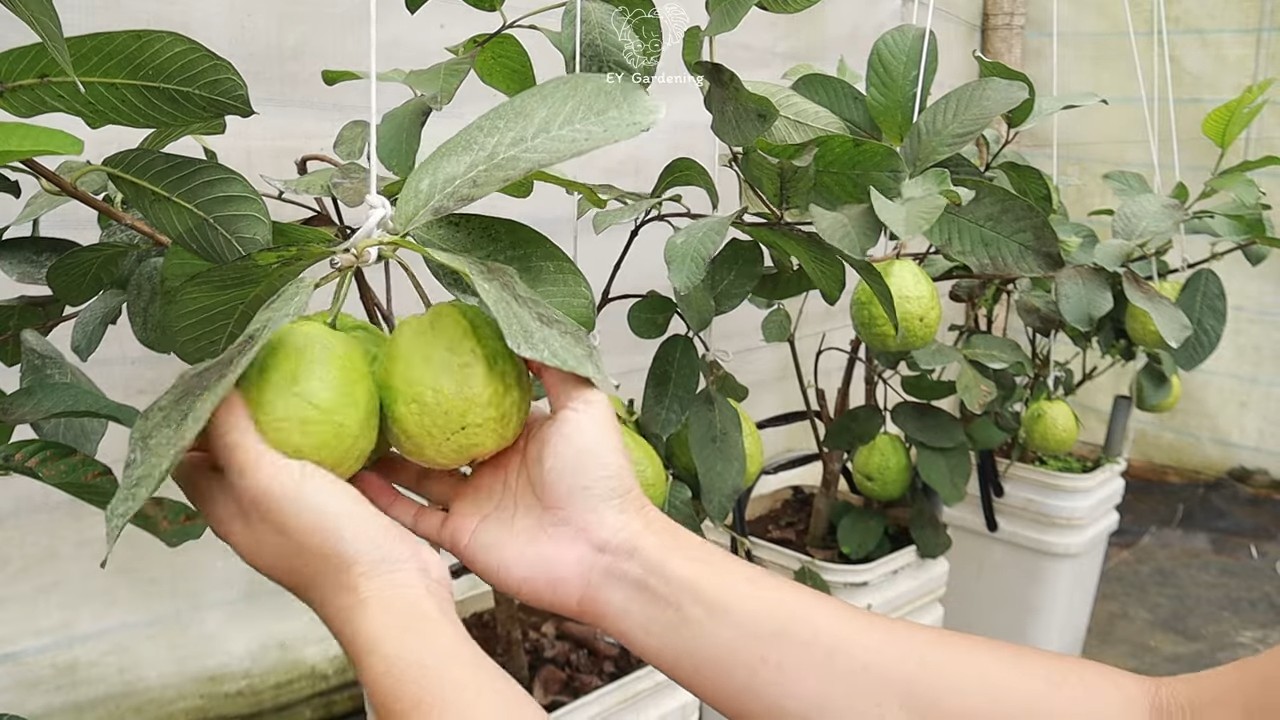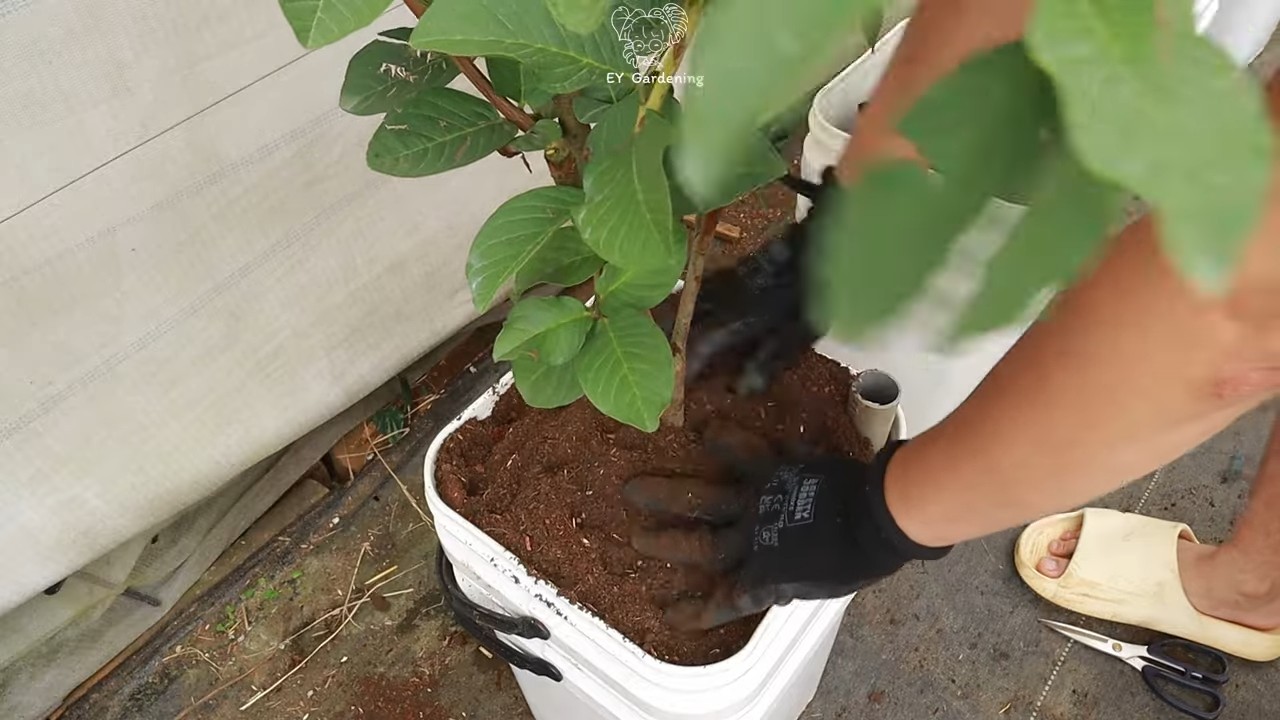Growing guava tree terrace gardens might seem like a tropical dream reserved for sprawling orchards, but I’m here to tell you that bringing the sweet, fragrant joy of guava to your own terrace is absolutely achievable! Forget the notion that you need acres of land; with a little know-how and some clever DIY tricks, you can cultivate your very own guava paradise, even in the heart of the city.
Guava, a fruit steeped in history and cultural significance across the globe, has been cherished for centuries. From its origins in Central America, where it was revered by ancient civilizations, to its widespread cultivation in Asia and beyond, the guava has always been more than just a delicious treat. It’s a symbol of abundance, health, and the simple pleasures of nature.
But why should you embark on this DIY adventure? Well, imagine stepping onto your terrace and plucking a sun-ripened guava, bursting with flavor, straight from your own tree. Think of the satisfaction of nurturing a plant from seedling to fruit, knowing you’ve created a little slice of tropical heaven. Plus, in today’s world, where access to fresh, healthy produce is more important than ever, growing guava tree terrace gardens offers a sustainable and rewarding way to connect with nature and enjoy the fruits (literally!) of your labor. This article is packed with easy-to-follow DIY hacks and tips that will empower you to create a thriving guava haven, no matter the size of your terrace. Let’s get started!

DIY: Creating a Thriving Guava Tree Terrace Garden
Hey there, fellow gardening enthusiasts! I’m so excited to share my experience with you on creating a beautiful and productive guava tree terrace garden. Guava trees are fantastic – they offer delicious fruit, lovely shade, and are relatively easy to care for once established. Building a terrace garden not only adds visual appeal but also helps with drainage and soil retention, especially on sloped areas. Let’s dive in!
Planning Your Guava Tree Terrace
Before we get our hands dirty, it’s crucial to plan. This will save you time, effort, and potential headaches down the road.
* Assess Your Space: Take a good look at the area where you want to build your terrace. Consider the slope, sunlight exposure (guava trees need at least 6-8 hours of direct sunlight), and existing vegetation.
* Soil Analysis: Guava trees thrive in well-draining soil with a slightly acidic to neutral pH (6.0-7.0). Get your soil tested to determine its pH and nutrient content. You can purchase a soil testing kit online or at your local garden center.
* Terrace Design: Decide on the number of terraces you want and their width. Wider terraces are easier to work with and provide more space for your guava tree and companion plants. A good starting point is 3-4 feet wide.
* Material Selection: Choose your retaining wall material. Common options include:
* Stone: Natural and aesthetically pleasing, but can be labor-intensive.
* Wood: Relatively inexpensive and easy to work with, but requires treatment to prevent rot.
* Concrete Blocks: Durable and easy to stack, but less visually appealing than stone.
* Treated Lumber: A good balance of cost and durability.
* Drainage: Proper drainage is essential to prevent waterlogging, which can kill your guava tree. Plan for drainage behind the retaining walls.
* Guava Variety: Select a guava variety that is well-suited to your climate and space. Some popular varieties include ‘Mexican Cream’, ‘Ruby Supreme’, and ‘Tropical White’. Consider dwarf varieties if you have limited space.
* Companion Plants: Think about what other plants you want to include in your terrace garden. Companion plants can attract pollinators, deter pests, and improve soil health. Some good options for guava trees include basil, marigolds, and nasturtiums.
Materials and Tools You’ll Need
Okay, now let’s gather our supplies. Here’s a comprehensive list:
* Guava Tree Sapling: Choose a healthy sapling from a reputable nursery.
* Retaining Wall Material: Stone, wood, concrete blocks, or treated lumber (enough to build your terraces).
* Gravel: For drainage behind the retaining walls.
* Landscape Fabric: To prevent soil erosion and weed growth.
* Soil: A mix of topsoil, compost, and well-rotted manure.
* Level: To ensure your terraces are level.
* Shovel: For digging and moving soil.
* Pickaxe (Optional): For breaking up hard soil.
* Wheelbarrow: For transporting materials.
* Measuring Tape: For accurate measurements.
* Gloves: To protect your hands.
* Safety Glasses: To protect your eyes.
* Tamper or Plate Compactor (Optional): For compacting the soil behind the retaining walls.
* Saw (If using wood): For cutting lumber to size.
* Drill (If using wood): For securing the retaining wall.
* Construction Adhesive (If using concrete blocks): For added stability.
* Drainage Pipe (Optional): For extra drainage in waterlogged areas.
* Watering Can or Hose: For watering your guava tree and plants.
* Mulch: To retain moisture and suppress weeds.
Building Your Guava Tree Terrace: Step-by-Step
Alright, let’s get to the fun part – building our guava tree terrace!
Phase 1: Preparing the Site
1. Clear the Area: Remove any existing vegetation, rocks, and debris from the area where you’ll be building your terrace. This includes grass, weeds, and any other obstacles.
2. Mark the Terraces: Use stakes and string to mark the outline of each terrace. This will help you visualize the layout and ensure that your terraces are evenly spaced. I like to use a measuring tape to ensure consistent width.
3. Excavate the First Terrace: Starting at the bottom of the slope, dig out the soil for the first terrace. The depth will depend on the height of your retaining wall material. Make sure to create a level base for the wall.
4. Compact the Base: Use a tamper or plate compactor to compact the soil at the base of the terrace. This will provide a stable foundation for your retaining wall.
Phase 2: Constructing the Retaining Walls
1. Build the First Retaining Wall: Begin constructing the retaining wall for the first terrace. If you’re using stone, carefully stack the stones, ensuring they are stable and interlocked. If you’re using wood, cut the lumber to the desired length and secure it with screws or nails. If you’re using concrete blocks, stack them and use construction adhesive to bond them together.
2. Install Drainage: Behind the retaining wall, install a layer of gravel for drainage. This will help prevent water from building up behind the wall and causing it to collapse. You can also install a drainage pipe at the base of the wall to direct water away from the terrace.
3. Backfill with Soil: Backfill the area behind the retaining wall with soil. Use a mix of topsoil, compost, and well-rotted manure to provide your guava tree with the nutrients it needs. Compact the soil as you backfill to prevent settling.
4. Repeat for Subsequent Terraces: Repeat steps 3-5 for each subsequent terrace, working your way up the slope. Make sure that each terrace is level and that the retaining walls are properly constructed.
Phase 3: Planting Your Guava Tree and Companion Plants
1. Prepare the Planting Hole: Dig a hole in the center of the top terrace that is twice as wide and as deep as the guava tree’s root ball.
2. Amend the Soil: Mix the soil you removed from the hole with compost and well-rotted manure. This will provide your guava tree with a nutrient-rich environment.
3. Plant the Guava Tree: Carefully remove the guava tree from its container and gently loosen the roots. Place the tree in the hole, ensuring that the top of the root ball is level with the surrounding soil.
4. Backfill the Hole: Backfill the hole with the amended soil, gently tamping it down as you go.
5. Water Thoroughly: Water the guava tree thoroughly after planting. This will help settle the soil and encourage root growth.
6. Plant Companion Plants: Plant your chosen companion plants around the guava tree. Be sure to space them appropriately to allow for growth.
7. Mulch: Apply a layer of mulch around the guava tree and companion plants. This will help retain moisture, suppress weeds, and regulate soil temperature.
Maintaining Your Guava Tree Terrace
Congratulations! You’ve successfully built your guava tree terrace garden. Now, let’s talk about maintenance to keep it thriving.
* Watering: Water your guava tree regularly, especially during dry periods. Guava trees need consistent moisture, but avoid overwatering, which can lead to root rot. Check the soil moisture by sticking your finger about an inch into the soil. If it feels dry, it’s time to water.
* Fertilizing: Fertilize your guava tree regularly with a balanced fertilizer. Follow the instructions on the fertilizer package. I usually fertilize mine in the spring and fall.
* Pruning: Prune your guava tree annually to maintain its shape and encourage fruit production. Remove any dead, damaged, or crossing branches. Pruning is best done in late winter or early spring before new growth begins.
* Pest and Disease Control: Monitor your guava tree for pests and diseases. Common pests include aphids, scale, and fruit flies. Common diseases include anthracnose and guava rust. Treat any infestations or infections promptly with appropriate pesticides or fungicides. Organic options are always a good first choice!
* Weeding: Regularly weed your terrace garden to prevent weeds from competing with your guava tree and companion plants for nutrients and water.
* Soil Amendment: Add compost and well-rotted manure to your soil annually to maintain its fertility.
* Mulch Replenishment: Replenish the mulch around your guava tree and companion plants as needed.
* Terrace Maintenance: Inspect your retaining walls regularly for any signs of damage or erosion. Repair any damage

Conclusion
So, there you have it! Transforming your terrace into a thriving guava haven is not only achievable but also incredibly rewarding. This DIY approach to growing guava trees offers a unique opportunity to connect with nature, enjoy fresh, homegrown fruit, and beautify your outdoor space, all while saving money and reducing your reliance on store-bought produce.
The beauty of this method lies in its adaptability. Feel free to experiment with different container sizes to suit your space and the guava variety you choose. Consider adding companion plants like basil or marigolds to deter pests and attract beneficial insects. You can also adjust the soil mix based on your local climate and the specific needs of your guava tree. For instance, if you live in a particularly dry area, incorporating more water-retentive materials like coco coir can be beneficial.
Don’t be afraid to get creative with your terrace garden design. Use trellises or other supports to train your guava tree into a desired shape, creating a stunning focal point. You can even incorporate other fruit trees or vegetables to create a diverse and productive edible landscape.
The key takeaway is that growing guava trees on your terrace is an accessible and fulfilling project for gardeners of all levels. It’s a chance to learn, experiment, and enjoy the fruits (literally!) of your labor. The satisfaction of harvesting your own guavas, knowing that you nurtured them from seedling to fruit, is unparalleled.
We strongly encourage you to give this DIY trick a try. Imagine stepping onto your terrace and being greeted by the sweet aroma of guava blossoms, or plucking a ripe, juicy guava straight from the branch. It’s an experience that will transform your terrace into a personal oasis.
And remember, the journey of growing a guava tree is just as important as the destination. There will be challenges along the way, but with patience, persistence, and a little bit of love, you’ll be rewarded with a bountiful harvest and a beautiful, thriving tree.
We’re eager to hear about your experiences! Share your photos, tips, and challenges in the comments below. Let’s create a community of guava-growing enthusiasts and learn from each other. Your insights could inspire others to embark on their own guava-growing adventures. Let us know what variety of guava you chose, what kind of soil mix you used, and any unique techniques you employed. Did you encounter any pests or diseases, and how did you manage them? The more information you share, the more valuable this resource will become for aspiring guava growers.
So, what are you waiting for? Grab your gardening gloves, gather your supplies, and get ready to transform your terrace into a guava paradise. Happy gardening!
Frequently Asked Questions (FAQ)
What is the best variety of guava to grow on a terrace?
The best guava variety for your terrace depends on your climate and personal preferences. Dwarf varieties like ‘Ruby Supreme’ or ‘Strawberry Guava’ are excellent choices for container growing as they don’t grow too large. ‘Mexican Cream’ is another popular option known for its sweet, creamy flesh. Consider your local climate and choose a variety that is well-suited to your growing conditions. Research the cold hardiness and disease resistance of different varieties before making your selection. You can often find information about suitable varieties from your local nursery or agricultural extension office.
What size container do I need for a guava tree?
Start with a container that is at least 15-20 gallons in size. As the tree grows, you may need to transplant it into a larger container, eventually reaching 25-30 gallons. The container should have adequate drainage holes to prevent waterlogging. Choose a container made of durable material like plastic, terracotta, or wood. Consider the weight of the container, especially when filled with soil and a mature tree, and ensure your terrace can support the load.
What type of soil is best for growing guava trees in containers?
Guava trees prefer well-draining soil that is rich in organic matter. A good potting mix for guava trees consists of equal parts of potting soil, compost, and perlite or vermiculite. This mixture provides good drainage, aeration, and nutrient retention. Avoid using garden soil, as it can be too heavy and compact in containers. You can also add a slow-release fertilizer to the soil mix to provide a steady supply of nutrients.
How often should I water my guava tree?
Water your guava tree regularly, especially during the growing season. The soil should be kept consistently moist but not waterlogged. Check the soil moisture level regularly by sticking your finger into the soil. If the top inch of soil is dry, it’s time to water. Water deeply, allowing the water to drain out of the drainage holes. Reduce watering during the dormant season.
How much sunlight does a guava tree need?
Guava trees need at least 6-8 hours of direct sunlight per day to thrive. Choose a sunny location on your terrace for your guava tree. If you live in a hot climate, provide some afternoon shade to protect the tree from scorching. If you don’t have enough sunlight, you can supplement with grow lights.
How often should I fertilize my guava tree?
Fertilize your guava tree regularly during the growing season (spring and summer). Use a balanced fertilizer specifically formulated for fruit trees. Follow the instructions on the fertilizer label for application rates. You can also use organic fertilizers like compost tea or fish emulsion. Avoid fertilizing during the dormant season.
How do I prune my guava tree?
Prune your guava tree regularly to maintain its shape, remove dead or diseased branches, and encourage fruit production. Prune in late winter or early spring before new growth begins. Remove any crossing or rubbing branches to improve air circulation. You can also prune to control the size and shape of the tree.
How do I protect my guava tree from pests and diseases?
Monitor your guava tree regularly for pests and diseases. Common pests include aphids, scale, and fruit flies. Common diseases include anthracnose and guava rust. Use organic pest control methods like insecticidal soap or neem oil to control pests. Prune regularly to improve air circulation and prevent diseases. You can also use copper-based fungicides to control fungal diseases.
How long does it take for a guava tree to produce fruit?
Guava trees typically start producing fruit within 2-4 years of planting. The exact time depends on the variety, growing conditions, and care. Grafted trees tend to fruit sooner than seedlings. Provide your guava tree with optimal growing conditions to encourage fruit production.
Can I grow a guava tree indoors?
While it’s possible to grow a guava tree indoors, it can be challenging. Guava trees need a lot of sunlight and humidity, which can be difficult to provide indoors. If you want to try growing a guava tree indoors, choose a dwarf variety and provide it with plenty of light and humidity. You may also need to hand-pollinate the flowers to ensure fruit production.





Leave a Comment